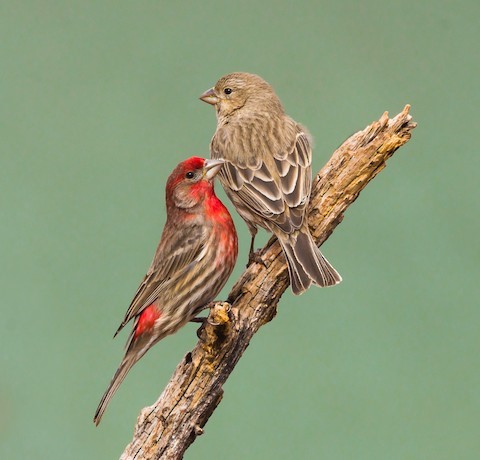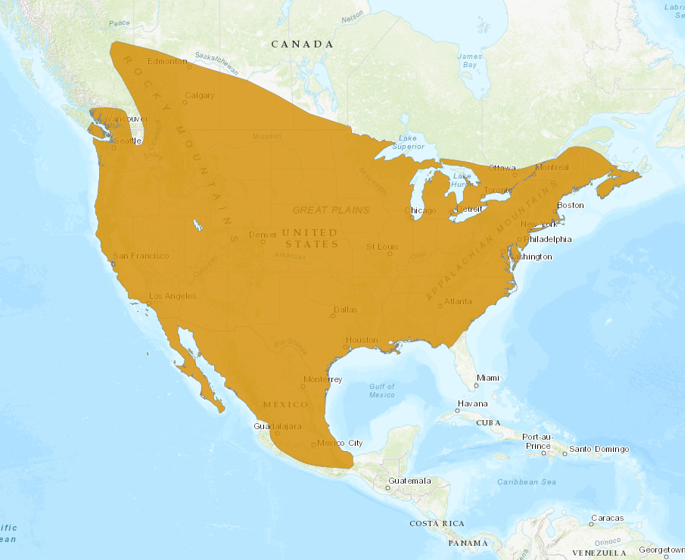Birdfinding.info ⇒ One of the commonest, most familiar of North American birds. Abundant nearly throughout the contiguous 48 states and Mexico south to Oaxaca, as well as Hawaii and parts of southern Canada. Especially abundant in California, the Southwest, the Eastern Seaboard from Boston to Pensacola, and several interior regions. A small but growing introduced population can be found in Athens, Greece, and its suburbs.
House Finch
Haemorhous mexicanus
North America from southern Canada to southern Mexico.
Native to North America and Mexico, west of the Great Plains, north to southern British Columbia and south to Oaxaca.
As its name implies, the House Finch has adapted well to human residential development.
An introduced population became established around the New York City area in the 1940s and spread rapidly along the Eastern Seaboard and into the Midwest. By the 1990s, the eastern population had spread west far enough to merge with the native population.
By the 2000s, the collective populations had spread nearly throughout the contiguous U.S. states and bordering areas of southern Canada. The last significant unoccupied gaps of the U.S. were in the northern Great Plains and southern Florida.
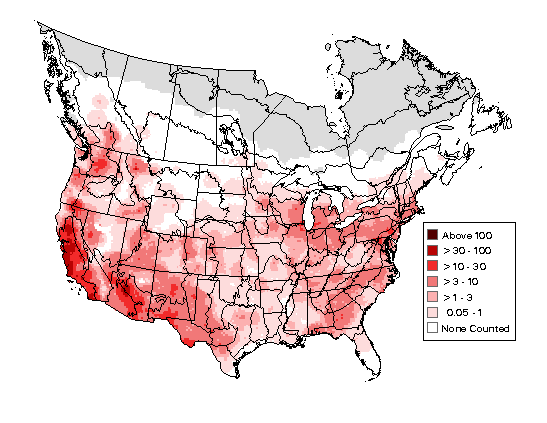
Breeding Bird Survey Abundance Map: House Finch. U.S. Geological Survey 2015
Expansion has continued more gradually north into Canada in settled areas to the Peace River Valley of northeastern British Columbia and Alberta, central Saskatchewan and Manitoba, southern Quebec (to the Gaspé Peninsula), New Brunswick, and western Nova Scotia.
Starting around the 1980s, a small population was noticed in central Chiapas.
Vagrants have reached Alaska (west to Anchorage, north to Delta Junction), the southern Yukon, and the southern Northwest Territories.
Introduced populations are established throughout the main Hawaiian Islands, in Murcia, Spain, and on the Attica Peninsula of central Greece.
Identification
The common red finch of the U.S., southern Canada, and Mexico. Compared to the similar species in its range, Purple and Cassin’s Finches, the reddish tones tend to be more scarlet, less rosy or pink, but it varies from yellow to orange to pinkish to scarlet. (For more details on distinguishing these three species, see Distinguishing Features: Identification of House, Purple, and Cassin’s Finches.)
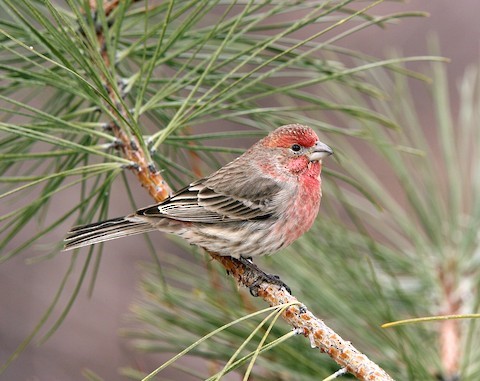
House Finch, male showing typical coloration and pattern. (Penticton, British Columbia; March 1, 2011.) © Laure Wilson Neish
The male is gray-brown overall with a reddish “visor,” throat, breast, and rump. The tone, extent, and brightness of the red vary widely.
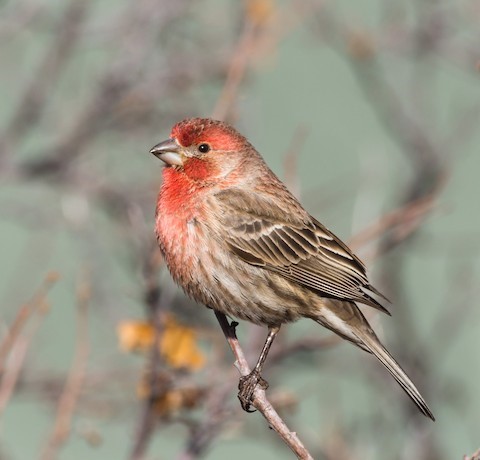
House Finch, male showing typical coloration and pattern, but a faint pinkish wash on the back. (Red Rock Canyon Open Space, Colorado Springs, Colorado; March 28, 2020.) © Jim Merritt
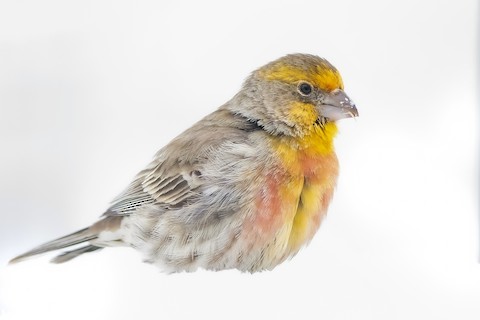
House Finch, male with typical but atypically yellowish coloration. (Newark, Ohio; February 18, 2021.) © Matthew Plante
The male’s red visor is a distinctive feature, a broad stripe that includes the forehead and eyebrows. The crown above is usually brownish and streaked, but it sometimes appears red.
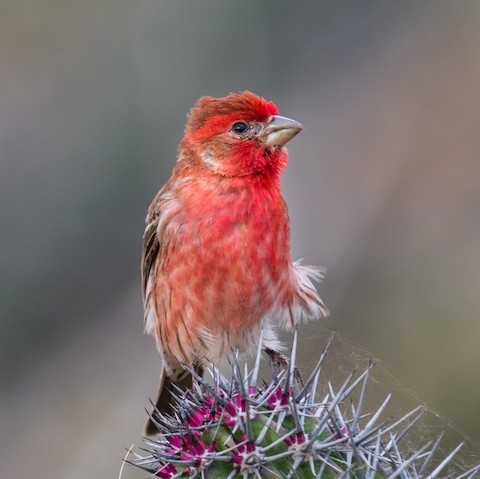
House Finch, male with abnormally vivid scarlet coloration—note that the red is most vivid on the forehead, brow, and throat. (La Paz, Baja California Sur, Mexico; March 13, 2020.) © Jim Merritt
A grayish-brown eyestripe broadens onto the cheek and separates the red visor from the red throat.
The male has a few broad, blurred brown streaks on its flanks and belly. Its back is brown with blurred streaks, sometimes with a subtle reddish blush.
The female is plain grayish-brown overall, indistinctly streaked throughout, with no discernible facial pattern—unlike the strong facial markings of female Purple and Cassin’s Finches.
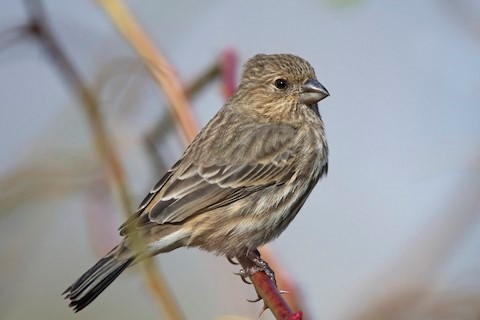
House Finch, female showing typical grayish-brown streaked plumage with no distinct head pattern. (Belle Isle Marsh Reservation, Boston, Massachusetts; November 14, 2020.) © Cody Matheson
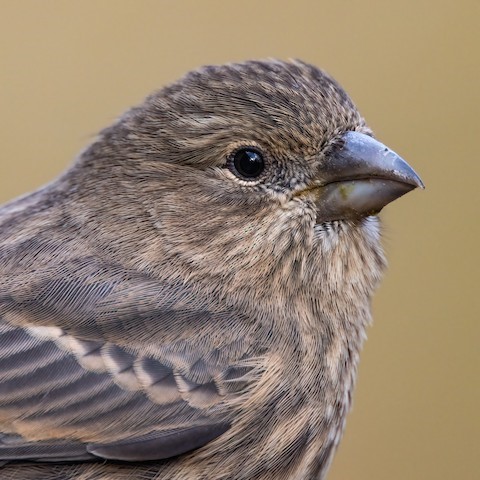
House Finch, female. (Lawrence, Indiana; October 16, 2020.) © Ryan Sanderson
Notes
Polytypic species consisting of approximately eleven or twelve recognized subspecies.
Additional Photos of House Finch

House Finch, male with typical coloration and pattern. (George Montgomery Sanctuary, Saint-Armand, Quebec; February 21, 2017.) © Suzanne Labbé

House Finch, brightly colored male in water fountain showing gray-brown eyestripe. (Commons Ford Ranch Metropolitan Park, Austin, Texas; April 11, 2016.) © Eric Barnes
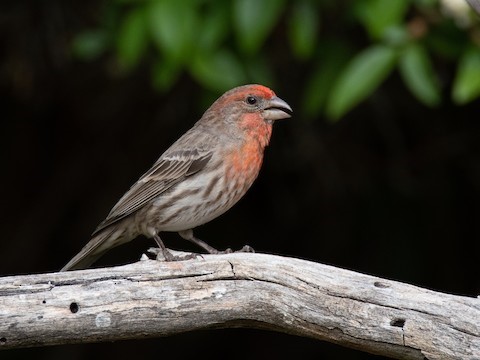
House Finch, male with typical coloration and pattern. (Glendale, Arizona; April 5, 2019.) © Levi Plummer

House Finch, male. (Arroyo Grande, California; July 19, 2021.) © Long-eared Owl
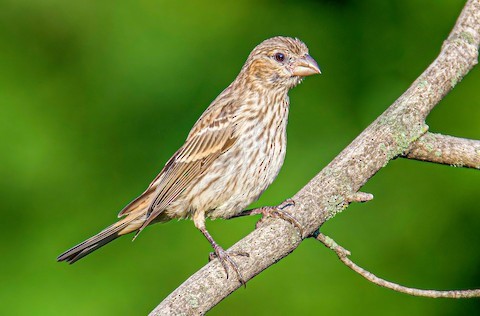
House Finch, immature male showing slight reddish tinges. (Johnstown, Ohio; August 6, 2021.) © Matt Mason
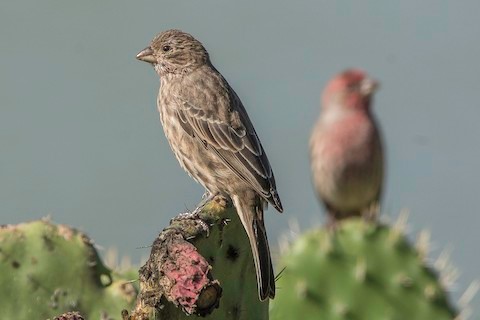
House Finch, female with male in the background. (Parque Tangamanga, San Luis Potosí, Mexico; November 2, 2019.) © Juan Miguel Artigas Azas
References
Alderfer, J., and J.L. Dunn. 2014. National Geographic Complete Birds of North America (Second Edition). National Geographic Society, Washington, D.C.
BirdLife International. 2018. Haemorhous mexicanus. The IUCN Red List of Threatened Species 2018: e.T22720563A132001810. https://dx.doi.org/10.2305/IUCN.UK.2018-2.RLTS.T22720563A132001810.en. (Accessed October 6, 2021.)
Clement, P., A. Harris, and J. Davis. 1993. Finches and Sparrows: An Identification Guide. Princeton University Press.
eBird. 2021. eBird: An online database of bird distribution and abundance. Cornell Lab of Ornithology, Ithaca, N.Y. http://www.ebird.org. (Accessed October 6, 2021.)
Howell, S.N.G., and S. Webb. 1995. A Guide to the Birds of Mexico and Northern Central America. Oxford University Press, Oxford.
Hume, J.P. 2017. Extinct Birds (Second Edition). Bloomsbury Publishing PLC, London.
Pyle, R.L., and P. Pyle. 2017. The Birds of the Hawaiian Islands: Occurrence, History, Distribution, and Status. Version 2 (January 1, 2017). http://hbs.bishopmuseum.org/birds/rlp-monograph/. B.P. Bishop Museum, Honolulu, Hawaii.
Xeno-Canto. 2020. House Finch – Haemorhous mexicanus. https://www.xeno-canto.org/species/Haemorhous-mexicanus. (Accessed October 6, 2021.)
